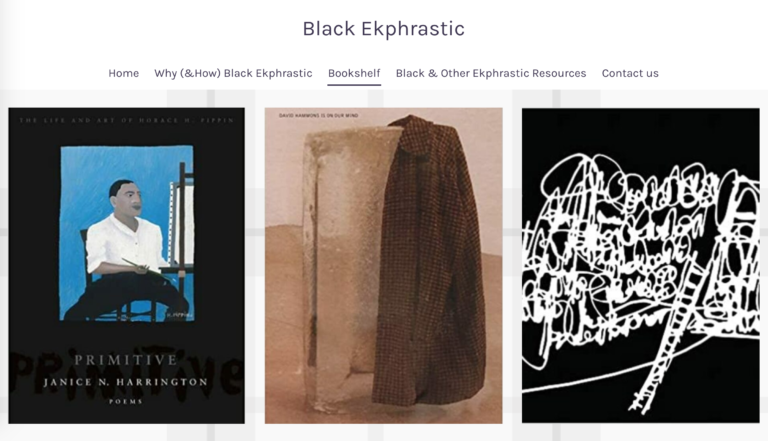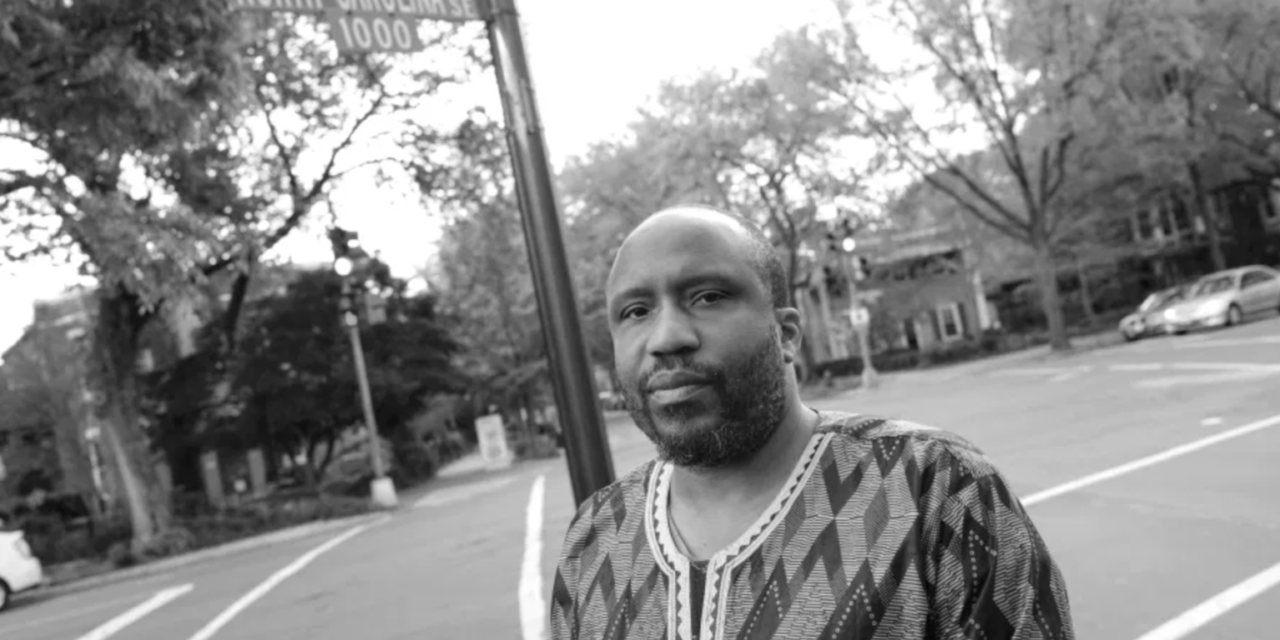Via the Orange County Arts Commission, Article by Emilie Menzel
Many of you are perhaps already familiar with Fred Joiner’s written forms of poetry. Since 2019, he’s served as Carrboro’s poet laureate, bringing poetry into the community through events like the West End Poetry Festival. His poems appear recently in anthologies like “Furious Flower: Seeding the Future of African American Poetry” beside poetry-world stars Danez Smith and Terrance Hayes.
Fred’s work within poetics, however, is more expansive than just the written medium. Like many poets, he understands poetry as an approach and way of acting, rather than a medium-dependent genre. Not surprisingly, then, in addition to writing poems, Fred works in a visual poetics as a curator. “To me, poets are interdisciplinary by nature,” he explains. “We’re taking things from our lived experience, we’re writing about music, we’re writing about nature, and we’re rendering it on a page, on a two-dimensional thing. So we’re already interdisciplinary… and the fact that we’re rendering something on the page in a particular way, with care to how it’s deployed on the page — we’re already visual artists.” As a curator and writer, he’s worked with museums and galleries such as the American Poetry Museum, CAM Raleigh, the Phillips Collection, the Reginald F. Lewis Museum, and more.

But taking a step back, what is curation, anyway? Curation can so easily be approached as an act of exclusion — a taking away, a leaving out. Per this definition, curation is to claim a form of ownership, the collector preening and pruning their fine feathers. Certainly, it’s important to maintain an awareness that to curate is in many ways a position of power. To curate is to make decisions about whose work is shown and how it is shown, and the world of gallery and museum exhibitions is, after all, so often a small handful of seed for so many flocks of beautiful birds.
Still, such a definition of curation maintains and amplifies those power dynamics, in addition to sadly limiting creative potential. Let us think, then, more boldly. Fred’s approach to curation is one of collaboration, that to curate is to provide an opportunity to bring artists, colors, and textures into the same room with one another. To curate, in this sense, is to create a catalyst for conversation. Curation as an act of creation, of care. And this too, for Fred has roots in a poetic perspective. “The root of the word curator is care. For me, the impulse to write a poem is care, is attention to something. So to me, curating, it’s the same impulse. … We use different materials to express that care, and express that cataloging and that presentation to the world, but that impulse is the same.”
Within the spirit of building conversations as care, Fred began the Black Ekphrastic project, a digital space for “re-writing the I” and “re-righting the eye.” The Black Ekphrastic project explores “how Black creative writing and arts by Black artists engage with one another” through recommendations of Black ekphrasis (i.e. art writing and art response) examples and resources. Fred’s work in amplifying these ekphrases is particularly important given the glut of ekphrases centering white creators. “When I google ekphrasis, nothing but white artists and white poets writing about white art comes up. Like are you serious? This is crazy. You mean to tell me there are no people of color painting or creating art and that’s why we aren’t writing about it? No, no, no. We’re not doing this. So that started me on a search of looking.” Black Ekphrastic helps gather a consolidated archive of a wealth of Black ekphrastic artists: Kevin Young, Evie Shockley, Robin Coste Lewis, the list continues.
The space also places more traditional art writing, like that in the MoMA book “Jacob Lawrence: The Migration Series,” beside more experimental, lyrical, and multi-modal art writings like Renee Gladman and Fred Moten’s “One Long Black Sentence.” Fred notes that this juxtaposition is an important conversation emerging in curation. “The art world is looking for a way to change the language, to change the lingua franca from this very staid, kind of colonial way of talking about something. So you see more lyric, poetic writing in the curatorial space. It’s necessary.”
Within physical spaces, Fred has worked closely with the American Poetry Museum in Washington, D.C. Through a partnership with the Phillips Collection (a museum known widely for, in particular, its Rothko room and collection of Jacob Lawrence’s Migration Series paintings), Fred curated a selection of artwork, readings, panels, and music for the Poetic Voices Series. The idea was to set the stage for conversation between the work of contemporary poets and the work of the Phillips’ collection holdings: the contemporary riffing beside the modern and older. In the spirit of interdisciplinary poetics, Fred called his curated tour of Phillips artwork “With a Poet’s Eye.”

Fred Joiner has an essay on the skillful simplicity of Simone Leigh’s sculptures, recently published in the Phillips’ essay collection Seeing Differently.
Most recently, Fred has collaborated as curator with the UNC Class of 2021 MFA in Studio Art candidates Sheyda Azar, Minoo Emami, Alena Mehić, Vonnie Quest, and Krysta Sa to create the Ackland exhibit “Micro/Macro.” After lengthy (virtual à la Covid) conversations with the artists about their work’s materials, forms, stories, and themes, Fred selected and presented artworks through Black feminist powerhouse Audre Lorde’s philosophy that “the personal is political.” This is to say that the selected artworks reach at macro-scale social concepts — e.g. the politicized body, addiction, community-knowledge — through an amplification of the micro — an individual or small community’s personal experiences. As Fred explains in his gallery description, “the personal nature of [the artists’] works challenges singular narratives and traditional understandings of pleasure, interiority, memory and migration, landscape, and healing.”
In the room of “Micro/Macro,” the gentle rhythms of the kitchen conversations in the artistic documentary “A bit of this, A bit of that” by Vonnie Quest follow you around the room. The flickering fluorescence in Minoo Emami’s projection installations is picked up in the electric intensity of Krysta Sa’s hyper focused video “materia remedia,” in the color saturated single object photographs from “Catalogue of 5,155 Miles” by Alena Mehić, in flashes of greens cooking in the pan in Quest’s video. Down the middle of the room, pulling through these amplified colors and sound, is Sheyda Azar’s raw “Internal Intimacy”: a womb-like pencil and oil on large canvas, pulled taught by fish hooks. At the bottom of the gallery description note, a small curator’s signature: Fred Joiner, guest curator and poet.
The exhibition Micro/Macro: Selected Works by the MFA Class of 2021 is on view at the Ackland now through May 22nd. For Covid safety precautions, the Ackland asks that you sign up for a time slot online before visiting in-person.
 Chapelboro.com has partnered with the Orange County Arts Commission to bring more arts-focused content to our readers through columns written by local people about some of the fantastic things happening in our local arts scene! Since 1985, the OCAC has worked to to promote and strengthen the artistic and cultural development of Orange County, North Carolina.
Chapelboro.com has partnered with the Orange County Arts Commission to bring more arts-focused content to our readers through columns written by local people about some of the fantastic things happening in our local arts scene! Since 1985, the OCAC has worked to to promote and strengthen the artistic and cultural development of Orange County, North Carolina.



